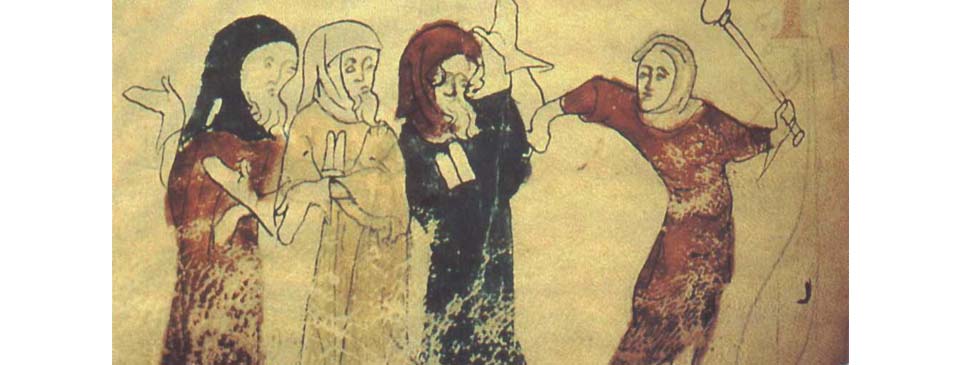The Jews of Medieval London

This illustration is from the margin of the manuscript ‘The Rochester Chronicle’, created in 1355 by the monk Edmund of Haddenham. It illustrates the expulsion of the Jews from England.
There were Jews living in London for two centuries during the Middle Ages. They were a valuable source of finance for the monarchs, nobles, sheriffs, and merchants and an essential part of the economy. Their money helped build castles, cathedrals, monasteries and abbeys (including Westminster Abbey), and pay for armies, wars and crusades. But they were also resented, often suffering extreme prejudice, oppression and massacre. Finally, they were banished from the country.
There had been a community of Jews in London since the Norman period. William the Conqueror was familiar with the small Jewish community of Rouen in Normandy and knew they had techniques for handling money. He encouraged them to come to England and they formed their own, largely insular, community in London, creating families that survived for two centuries. Jews mingled with English, French, Norse, Danes, Germans and Flemings in what was a very cosmopolitan town. They were worldly, scholarly, cultivated, sophisticated, and numerate compared to the general population, and wealthy. The community must have existed in France for a long period because at the time of their arrival they spoke in a form of medieval French and had French names.
The Norman monk Gilbert Crispin became Abbot of Westminster Abbey in 1085. One of his famous writings concerns a conversation with a learned Jew who came to London at about that time. In Dialogue between a Christian and a Jew Gilbert shows a kindly and humane attitude towards his Jewish friend.
Jews were forbidden to hold land in England and by necessity and tradition they tended to be specialists in various trades except that of agriculture. Over many centuries they had gained experience in dealing in business and finance across long distances as far as China, although by the 11th century they had been surpassed in long-distance trade.
During the medieval period the Christian Church forbade usury, the lending of money for interest. It was a rule that did not apply to the Jews, who were sophisticated in methods of giving credit, so they became useful to the monarchs, aristocracy and merchants as a source of finance, as did the Knights Templar in the 12th century. Rates of interest could be as high as one hundred percent and borrowers mortgaged their land to Jewish lenders as security. Although Jews were barred from owning the land, they could arrange where necessary for a third party to acquire it in return for clearing the debt of a borrower. There are surviving records that show transfers of land for that reason.
The position of Jews in Europe was far from secure after the Pope called for the First Crusade in the 1090s. His intended target was Muslims but his initiative encouraged Christians across Europe to attack any non-believer. In England Jews received protection and assistance from the monarchs, but without rights other than that graciously allowed them, and they required a royal permit to set up in trade. That protection was immensely important. They were wards of the monarch, which protected them while they were useful. Harming a Jew was damaging the king’s property, resulting in severe punishment.
William II (who enjoyed shocking intolerant churchmen by giving patronage to ‘infidels’) valued them for financing his army. It was Henry I who fully grasped the value of Jews, however, and the London Jewry seems to date from his reign. The leading member of the Jewry then was Rabbi Josce of Rouen. His sons Isaac and Abraham were businessmen and money-lenders and Isaac kept a house on Cheapside. During the early years of Henry II they were lending money to the King. Loans to the monarch were necessary but not profitable for the lenders and were effectively a form of taxation; the real money to be made came from lending to landowners and merchants.
London’s Jewish Quarter in the 12th century spread over nine parishes. Its main part was immediately south of the Guildhall down to Catte (Gresham) Street and Westcheap (Cheapside). On the west side it was bordered by Milk Street and Jew’s Street in the east (the modern-day Old Jewry, of which there are records as far back as 1128), with Lawrence Lane in its centre. The name Milk Street may be derived from the Hebrew word ‘melech’, meaning ‘king’. The Christian parish church of St. Lawrence Jewry stood within the Jewish quarter.
It is significant that the Jewry was located in the same area as the Guildhall, London’s seat of local government, as it was in other European towns. Christians and Jews moved about together in the Jewish Quarter during the day but Christians could be fined for being there at night. The Jews built synagogues in the surrounding streets at the modern-day Ironmonger Row, Gresham Street, Basinghall Street, Coleman Street and Threadneedle Street.
Archaeologists discovered a mikveh, a Jewish ritual bath, from the mid-13th century, under a modern building in Milk Street in 2001. It has been reconstructed at the Jewish Museum in Camden Town. Some of England’s oldest surviving secular Hebrew text is contained within contracts still held in the National Archives regarding the purchase of property in London.
Jews had only one burial ground in England, outside the city wall at Cripplegate, and they had to transport their dead there from other towns. It is now partly covered by the Barbican development. In 1177 Henry II allowed others to be established and there were later cemeteries created at York and Winchester. A tax of three and a half pence was payable on every Jewish burial.
Some Jews went into professions as doctors, goldsmiths, pawnbrokers, rabbis, cheesemongers, fishmongers, and vintners. One Marlibrun of Billingsgate was an artist, and Elijah Menahem a leading translator and Judaic theologian with an impressive library.


